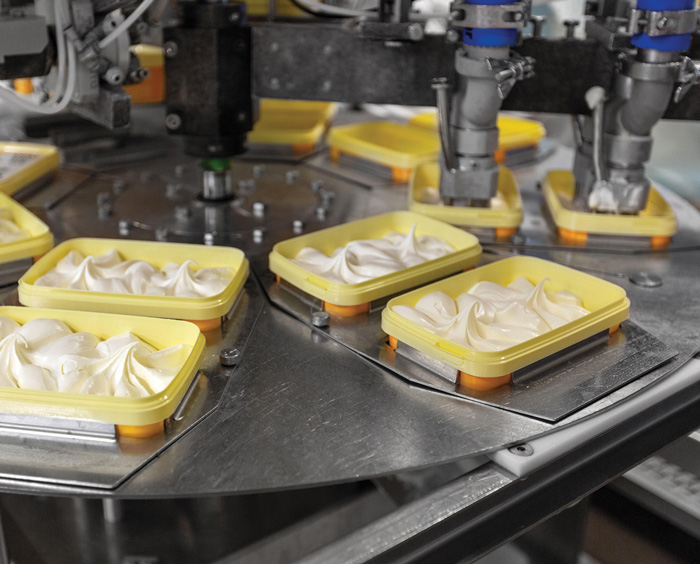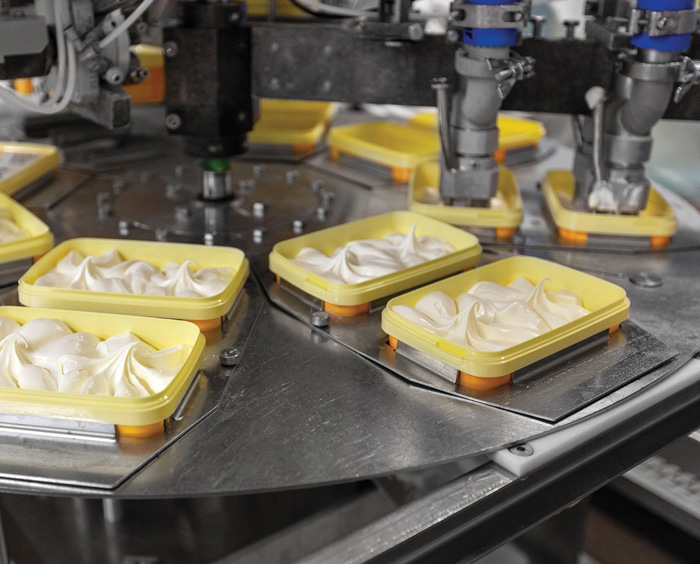The Scoop: How Ice Cream is Made
Processing | APPLIED SCIENCE
“I scream, you scream, we all scream for ice cream!” The sentiment behind these well-known lyrics from the 1927 novelty song, “Ice Cream,” has stood the test of time in describing how people feel about the tasty frozen dairy treat. Whether we’re screaming about it or not, millions of us enjoy consuming it. According to Grand View Research, ice cream has an estimated market size value of $81.8 billion per year in the United States.
The ingredients and the processes used to make ice cream are essential to create a smooth and creamy texture worthy of the scream. The U.S. Food and Drug Administration defines ice cream as a food produced by freezing while stirring a pasteurized mix that consists of one or more optional dairy ingredients listed in part B of 21 CFR 135.110. Ice cream must contain 1.6 lb or greater of total solids and weigh 4.5 lb or greater, both per gallon, contain a minimum of 10% milkfat, with exceptions listed in 21 CFR 135.110, and contain less than 1.4% egg yolks by weight.
A Smooth Process
The process of making ice cream starts with dry ingredients (sugar, stabilizers, dried eggs, or milk), which are mixed into liquid ingredients (milk, cream) by one of two methods. In the first method, a powder horn contains a funnel to control the addition of dry ingredients to the liquid, passing the two through an impeller before cycling the mixture to allow the addition of optional dry ingredients. The second is to add all dry ingredients at the same time into a high shear mixing device. Flavorings like vanilla, chocolate, mint, or fruit extracts are common ingredients incorporated at this stage.
The ice cream mixture is then pasteurized, commonly at either 155°F for 30 min or 174°F for 25 sec, and homogenized. Batch and continuous pasteurization are employed in the industry. The latter, which is faster and more efficient, is most often used by commercial ice cream manufacturers. During pasteurization, bacterial cells are killed and the milk fat solids are melted within the mix in preparation for homogenization. In a separate chamber, the hot mix is forced through small openings at high pressure (2,000/500 psi) to reduce the liquid fat droplets to a small, uniform size.
Homogenization is integral to ice cream’s smooth texture and prevents fats from churning in the later freezing stage. The mixture is cooled to about 5°C (40°F) and aged for approximately 12 hr to allow the fat to partially crystallize. This step also allows the proteins and stabilizers to solubilize so that they can keep the fat particles small and entrap the air.
Next, the ice cream is frozen quickly to maintain the smooth texture. The product is placed in a barrel freezer in which rotating blades continually agitate the mixture. The churning prevents large water crystal formation and incorporates significant volumes of air. In fact, the volume of the ice cream can increase by 60% to 100% simply because air is added.
The incorporation of air is crucial. It makes the ice cream softer and slows the melting process. Without air, ice cream would be too hard to eat. After incorporating air, sizeable flavorings such as candy pieces, nuts, or fruit chunks can be added, along with other flourishes like ripples and variegates. This step is completed in a line freezer immediately before packaging. These hardening rooms, which contain blast freezers set at temperatures below -30°C (-22°F), maintain product comprised of very small ice crystals, which leads to a desired smooth texture and flavor release.
Ingredient Functionality and Nondairy Inclusions
Ice cream mixes consist of milk, which contains >80% water, casein and whey proteins (>3% protein), lactose, minerals, and milk fat (>3%). Cream is used, which is >80% moisture, 11%–12% milk fat, and approximately 3% protein. The most predominant component in ice cream is water, at 55%–65%. The total solids are between 35%–42%, a percentage that increases as fat content increases. Fat content is commonly between 10%–16%. Cream, milk, buttermilk, whey, and skim milk are the main contributors of water, fat, and protein (approximately 3%) to the ice cream.
Milk supplies 4%–5% of the carbohydrates in ice cream in the form of lactose. Lactose helps with seeding, providing a nucleation site for small ice crystals to form, which is crucial for smooth texture. Milk proteins, most specifically casein, are strong emulsifiers because they contain both long sections of polar side chains and long sections of nonpolar side chains. The polar side chains orient to the large amount of water and other polar compounds in the ice cream. The nonpolar side chains orient to the small fat globules to form an emulsion and the air that has been incorporated in the ice cream to form a foam.
A closer look at three commercially available products provides a better understanding of the functionality and purpose of nondairy ingredients in ice cream. The first, Ben & Jerry’s Strawberry Ice Cream with chunks of strawberries, is not sold in retail stores, but is only offered at Ben & Jerry’s “Scoop Shops” in various locations across the globe. The other two ice creams—Mayfield Signature Vanilla Ice Cream and Prairie Farms Belgian Chocolate Ice Cream—are sold in grocery stores.
Ben & Jerry’s Strawberry Ice Cream (with chunks of strawberries) Ingredient Statement: CREAM, SKIM MILK, STRAWBERRIES, LIQUID SUGAR (SUGAR, WATER), SUGAR, EGG YOLKS, GUAR GUM, CARRAGEENAN
Ben & Jerry’s ice cream contains sugar dissolved in water, sugar, egg yolks, guar gum, and carrageenan. The sugar is sucrose, which provides the desired sweetness and also contributes to the ice cream’s smooth, creamy texture by contributing to seeding, which helps to prevent ice crystal formation. If a portion of the sugar is removed from the formulation, sweetness will decrease but the texture will be less creamy and smooth and the freezing point will increase, which will negatively impact texture.
Although many companies do not include egg yolks in their ice cream since it introduces an additional allergen, this Ben & Jerry’s product does include them. Egg yolks contain fat in the form of triglycerides that contribute to the creamy texture and protein and lecithin that help emulsify the fat and entrap air to stabilize the emulsion and foam. One main difference between custards and ice cream is that custards must contain 1.4% pasteurized egg yolk, increasing the product’s creaminess and smoothness. Guar gum and carrageenan are long chain polysaccharides that increase the glass transition temperature of the ice cream, which increases the temperature that is needed to freeze the ice cream and store the ice cream. Kappa carrageenan is commonly used in ice creams and other dairy products because the negative charges of sulfate on carrageenan interact with the positive charged amino acid side chains in casein, further stabilizing the product and maintaining solution homogeneity.
Mayfield Signature Vanilla Ice Cream Ingredient Statement: CREAM, BUTTERMILK, WHEY, SUGAR, CORN SYRUP, SKIM MILK, NATURAL FLAVORS, PLANT BASED GUMS (GUAR, TARA), ANNATO (COLOR)
In addition to the dairy ingredients, the Mayfield brand natural vanilla ice cream also contains corn syrup, tara gum, and annatto. Corn syrup is a liquid that contains glucose and fructose, which are the monosaccharides that make up sucrose and increase sweetness and soluble solids. Tara gum functions like guar gum and carrageenan to stabilize the product by contributing to the smooth, creamy texture.
Prairie Farms Belgian Chocolate Ice Cream Ingredient Statement: MILK, CREAM, SUGAR, SKIM MILK, CORN SYRUP, COCOA (PROCESSED IN ALKALI), WHEY, STABILIZER (MONO AND DIGLYCERIDES, GUAR GUM, CELLULOSE GUM, AND CARRAGEENAN)
As shown, Prairie Farms Belgian Chocolate ice cream contains similar ingredients to the Ben & Jerry’s and Mayfield ice creams, but this product also includes cocoa for the chocolate flavor and a stabilizer that contains guar gum, carrageenan, and mono- and diglycerides. The carrageenan helps keep the cocoa in solution. The mono- and diglycerides are emulsifiers that help reduce the strain on the milk proteins and polysaccharide gums to help emulsify the fat and stabilize the air in the foam.
Stay Frosty
Process and new ingredient solutions will help food scientists continue to make outstanding ice cream, alleviate supply chain challenges, and allow for labels with fewer ingredients. Such advances also will help improve the quality of plant-based dairy product dessert alternatives and ensure that ice cream continues to meet consumer expectations in a “scream”-worthy way.
Learning Objectives
- Gain insight into the importance of homogenization, pasteurization, and incorporating air into the ice cream mix.
- Understand the function of dairy and nondairy ingredient components in ice cream.
- Learn about the function of egg yolks, sugars, polysaccharides, and stabilizers in ice cream.




